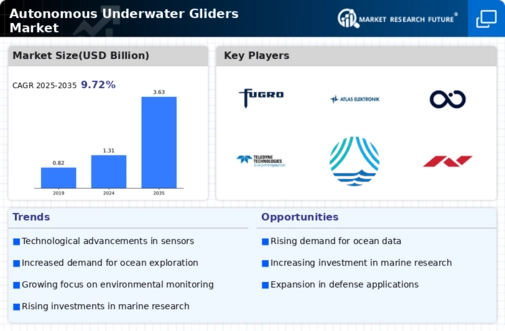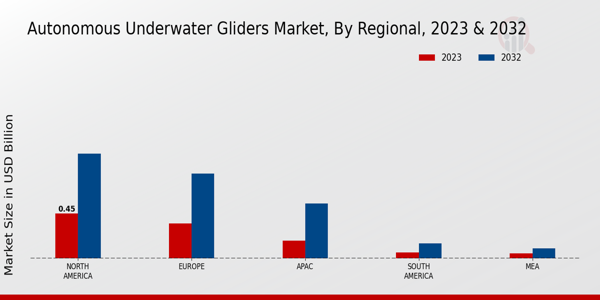Market Growth Projections
The Global Autonomous Underwater Gliders Market Industry is projected to experience substantial growth over the coming years. With an estimated market value of 1.31 USD Billion in 2024, it is expected to reach 3.63 USD Billion by 2035. This growth trajectory suggests a compound annual growth rate (CAGR) of 9.71% from 2025 to 2035. Such projections reflect the increasing adoption of autonomous underwater gliders across various sectors, including research, environmental monitoring, and defense. The market's expansion is indicative of the growing recognition of the value these technologies bring to underwater exploration and data collection.
Advancements in Technology
Technological advancements are significantly influencing the Global Autonomous Underwater Gliders Market Industry. Innovations in sensor technology, battery life, and data transmission capabilities enhance the operational efficiency and effectiveness of these gliders. For example, the integration of advanced acoustic sensors allows for more precise data collection, which is essential for scientific research and environmental monitoring. As technology continues to evolve, the capabilities of autonomous underwater gliders expand, making them more appealing to research institutions and environmental agencies. This trend is likely to contribute to the market's growth trajectory, as organizations seek to leverage cutting-edge technology for underwater exploration.
Rising Environmental Concerns
Growing environmental concerns are propelling the Global Autonomous Underwater Gliders Market Industry forward. As awareness of ocean health and biodiversity increases, there is a pressing need for effective monitoring solutions. Autonomous underwater gliders provide a cost-effective means of gathering data on pollution levels, marine life, and habitat conditions. Government agencies and environmental organizations are increasingly adopting these technologies to inform policy decisions and conservation efforts. This heightened focus on environmental sustainability is expected to drive market growth, as stakeholders recognize the value of data-driven insights in addressing ecological challenges.
Government Initiatives and Funding
Government initiatives and funding play a crucial role in shaping the Global Autonomous Underwater Gliders Market Industry. Various national and international programs are being established to promote marine research and technology development. For instance, the European Union has allocated significant resources to marine research projects that utilize autonomous underwater gliders for data collection. Such funding not only supports the development of new technologies but also encourages collaboration among research institutions and private companies. As governments prioritize marine research, the market is likely to benefit from increased investment and support, fostering innovation and growth.
Growing Applications in Defense and Security
The Global Autonomous Underwater Gliders Market Industry is witnessing an expansion in applications within the defense and security sectors. These gliders are increasingly utilized for surveillance, reconnaissance, and underwater mapping, providing strategic advantages in maritime operations. For example, the United States Navy employs autonomous underwater gliders for intelligence gathering and environmental assessments in operational theaters. As geopolitical tensions rise, the demand for advanced underwater capabilities is expected to increase, further driving market growth. This trend indicates a diversification of applications, positioning autonomous underwater gliders as essential tools in modern defense strategies.
Increasing Demand for Oceanographic Research
The Global Autonomous Underwater Gliders Market Industry is experiencing a surge in demand driven by the need for extensive oceanographic research. These gliders are pivotal in collecting data on ocean currents, temperature, and salinity, which are crucial for understanding climate change and marine ecosystems. For instance, the National Oceanic and Atmospheric Administration (NOAA) utilizes these gliders to monitor ocean conditions, contributing to a more comprehensive understanding of marine environments. As research initiatives expand, the market is projected to grow from 1.31 USD Billion in 2024 to 3.63 USD Billion by 2035, reflecting a compound annual growth rate (CAGR) of 9.71% from 2025 to 2035.




















